EIA Framework | Environmental Law - CLAT PG PDF Download
What is EIA?
Environmental Impact Assessment (EIA) is a process used to identify and evaluate the potential effects of a proposed project or development on the environment, society, and economy. Think of it as a "check-up" for projects like building dams, highways, factories, or power plants before they are approved. The goal is to understand how these projects might affect nature, people, and resources, so we can make better decisions.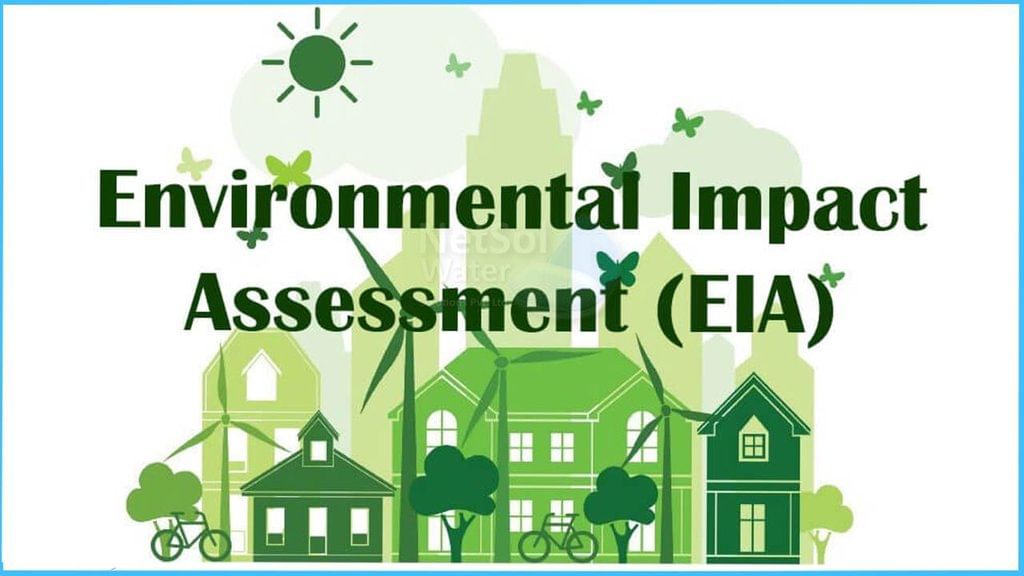
Definition of EIA
EIA is a systematic process that studies the possible positive and negative impacts of a project. It looks at how a project might affect:
- Environment: Air, water, soil, forests, wildlife, etc.
- Society: Local communities, health, livelihoods, culture, etc.
- Economy: Jobs, infrastructure, local businesses, etc.
Purpose of EIA
The main purposes of EIA are:
- Promote Sustainable Development: Ensure projects meet human needs without harming the environment for future generations.
- Prevent Environmental Damage: Identify potential problems early and suggest ways to avoid or reduce harm.
- Support Informed Decision-Making: Provide clear information to governments, developers, and the public to make smart choices about approving or modifying projects.
Objectives of EIA
EIA has clear goals to make sure projects are safe and sustainable. These include:
- Assessing Impacts: Understand how a project might change the environment, society, or economy.
- Finding Alternatives: Suggest better ways to carry out the project with less harm (e.g., changing the location or design).
- Reducing Negative Effects: Recommend measures to minimize damage, like using cleaner technology or restoring affected areas.
- Involving the Public: Allow local communities and stakeholders to share their concerns and suggestions.
- Ensuring Compliance: Make sure projects follow environmental laws and regulations.
Historical Context of EIA
- Global Origin: The concept of EIA started with the National Environmental Policy Act (NEPA) in the United States, passed in 1969. NEPA required the U.S. government to assess the environmental impacts of major federal projects. This law inspired many countries to adopt similar processes to protect their environments.
- EIA in India: In India, EIA became a formal process under the Environment (Protection) Act, 1986. The government introduced the first EIA Notification in 1994, which made it mandatory for certain projects to undergo an environmental assessment before getting approval. Over time, the process has been updated to make it more effective and inclusive.
Legal Basis of EIA in India
EIA in India is backed by strong laws and regulations to ensure projects are environmentally safe. Here’s a simple breakdown:
1. Primary Legislation
The Environment (Protection) Act, 1986 is the main law that governs environmental protection in India. Under Section 3 of this Act, the Central Government has the power to:
- Regulate projects that could harm the environment.
- Set rules to control pollution and protect natural resources.
- Require environmental assessments for specific projects.
2. Key Regulation
The EIA Notification, 2006 (and its amendments) is the most important regulation for the EIA process in India. It was issued under the Environment (Protection) Act and outlines:
- Which projects need an EIA (e.g., large industries, mining, dams, etc.).
- The steps involved in the EIA process (like screening, scoping, public consultation, and appraisal).
- The roles of government authorities, project developers, and the public.
The EIA Notification has been amended several times to improve the process, make it more transparent, and address new environmental challenges.
Why is EIA Important?
EIA is like a safety net for the environment and society. Here’s why it matters:
- Protects Nature: Helps save forests, rivers, and wildlife from harmful projects.
- Empowers Communities: Gives local people a voice to express their concerns about projects that affect their lives.
- Encourages Smart Planning: Helps developers design projects that are safer and more sustainable.
- Avoids Costly Mistakes: Identifying problems early can save money and prevent disasters later.
EIA Notification, 2006
The EIA Notification, 2006, issued by the Ministry of Environment, Forest and Climate Change (MoEFCC) under the Environment (Protection) Act, 1986, is a key regulation in India that governs the Environmental Impact Assessment (EIA) process. It replaced the EIA Notification, 1994, with the aim of:
- Streamlining the EIA process to make it more efficient.
- Strengthening compliance with environmental laws.
- Ensuring that projects with potential environmental impacts are carefully evaluated before approval.
The notification mandates an EIA for projects listed in its Schedule, such as mining, thermal power plants, highways, and large construction projects. It outlines the process, roles, and responsibilities for assessing and approving these projects.
Key Provisions of EIA Notification, 2006
Applicability
The EIA Notification, 2006, applies to projects listed in Schedule 1, which are divided into two main categories based on their size, scale, and potential environmental impact:
1. Category A:
- Large-scale projects with significant environmental impacts.
- Require clearance from the MoEFCC (Central Government).
- Examples: Airports, nuclear power plants, large dams, and major industrial projects.
2. Category B:
- Smaller projects with relatively lower environmental impacts.
- Require clearance from State Environment Impact Assessment Authorities (SEIAA).
- Further divided into:
- Category B1: Requires a full EIA process (e.g., medium-scale industries).
- Category B2: Exempted from a full EIA but may need other environmental clearances (e.g., small construction projects).
- Examples: Building and construction projects, small-scale mining.
Exemptions
Certain projects are exempt from the EIA process, subject to conditions, including:
- Small-scale units with low environmental impact.
- Defense-related projects critical to national security.
- Projects in emergency situations (e.g., disaster relief infrastructure).
However, exemptions are granted only after careful scrutiny to ensure environmental safety.
Stages of the EIA Process (EIA Notification, 2006)
The EIA Notification, 2006, outlines four key stages for the EIA process:
1. Screening:
- Determines whether a project requires a full EIA.
- Applicable only to Category B projects (Category A projects automatically require an EIA).
- Outcome: Projects are classified as B1 (EIA required) or B2 (EIA exempted).
2. Scoping:
- Identifies the key environmental issues to be studied in the EIA.
- The Expert Appraisal Committee (EAC) (for Category A) or SEIAA (for Category B) prepares a Terms of Reference (ToR) to guide the EIA study.
3. Public Consultation:
- Involves local communities and stakeholders to gather their opinions and concerns.
- Includes:
- Public Hearing: A meeting where people can voice their views on the project.
- Written Submissions: Stakeholders can submit feedback in writing.
- Exemptions: Some projects (e.g., defense or strategic projects) may skip this step.
4. Appraisal:
- The EIA report is reviewed by the EAC (for Category A) or SEIAA (for Category B).
- Experts evaluate the project’s impacts, mitigation measures, and public feedback.
- Outcome: The project is either approved (with conditions), rejected, or sent back for further study.
Amendments to EIA Notification, 2006
Since 2006, the EIA Notification has been amended several times to address emerging challenges, improve efficiency, and respond to criticisms. Key amendments include those in 2014, 2016, and 2020. Below is a summary of significant changes:
1. 2014 Amendments:
- Simplified Procedures: Reduced the time taken for clearances by streamlining processes.
- Project Categorization: Clarified the classification of projects into Category A, B1, and B2 to avoid confusion.
- Exemptions: Expanded exemptions for certain low-impact projects, like small-scale renewable energy projects, with strict conditions.
2. 2016 Amendments:
- Decentralization: Strengthened the role of SEIAA for Category B projects to reduce delays at the central level.
- Compliance Monitoring: Introduced stricter measures to ensure projects follow environmental conditions after approval.
- Public Consultation: Made public hearings more inclusive by allowing virtual participation in some cases.
3. 2020 Amendments:
- Post-Facto Clearance: Allowed projects that started without prior environmental clearance to apply for approval after paying penalties (controversial provision).
- Reduced Public Consultation Time: Shortened the period for public feedback in some cases to speed up approvals.
- Exemptions Expanded: Certain projects, like small-scale inland waterways, were exempted from full EIA requirements.
These amendments aimed to balance environmental protection with faster project approvals but faced criticism for potentially weakening safeguards.
EIA Draft Notification, 2020
In 2020, the MoEFCC released a Draft EIA Notification to replace the 2006 Notification. This draft proposed significant changes but faced widespread criticism. As of April 2025, the Draft Notification has not been enforced, but it remains relevant for discussions, especially for exams. Below are its key provisions, criticisms, and status:
Key Provisions of the Draft Notification, 2020
Post-Facto Clearance:
- Allowed projects operating without prior environmental clearance to seek approval after starting operations, subject to penalties.
- Aim: Legalize projects that violated environmental norms but are economically important.
Reduced Public Consultation:
- Shortened the time for public hearings from 30 days to 20 days in some cases.
- Exempted more projects (e.g., strategic or linear projects like highways) from public consultation.
Expanded Exemptions:
- Increased the number of projects classified as Category B2 (exempted from EIA).
- Examples: Small-scale mining, certain chemical manufacturing units.
Compliance Reporting:
- Reduced the frequency of compliance reports from every six months to once a year for some projects.
- Aim: Reduce the burden on project developers.
Criticisms of the Draft Notification, 2020
The Draft Notification sparked significant controversy due to concerns that it weakened environmental protections. Key criticisms include:
Post-Facto Clearance:
- Critics argued it encouraged violations by allowing illegal projects to seek approval after causing environmental damage.
- Seen as a setback to the “polluter pays” principle.
Reduced Public Participation:
- Shortening public consultation periods limited the ability of local communities, especially in remote areas, to voice concerns.
- Exempting strategic projects from public hearings raised transparency issues.
Weakened Oversight:
- Expanded exemptions for Category B2 projects were seen as risky, as many small projects collectively cause significant environmental harm.
- Less frequent compliance reporting could reduce accountability.
Environmental Risks:
Environmentalists and activists argued the draft prioritized economic growth over sustainability, potentially leading to deforestation, pollution, and loss of biodiversity.
Public and Legal Response
- Protests: The draft triggered nationwide protests by environmentalists, students, and local communities.
- Legal Challenges: Several petitions were filed in courts, including the Delhi High Court, to block the draft.
- Government Response: The MoEFCC extended the deadline for public feedback due to opposition but has not finalized the draft as of 2025.
Status (as of April 2025)
- The Draft EIA Notification, 2020, has not been notified or enforced.
- The EIA Notification, 2006, along with its amendments, remains in force.
- The draft is still relevant for discussions, as it reflects ongoing debates about balancing development and environmental protection.
Stages of the EIA Process in India
The Environmental Impact Assessment (EIA) process in India, as outlined under the EIA Notification, 2006, consists of four main stages: Screening, Scoping, Public Consultation, and Appraisal, followed by Post-Clearance Monitoring. Each stage has a specific purpose, involves key stakeholders, and faces potential challenges.
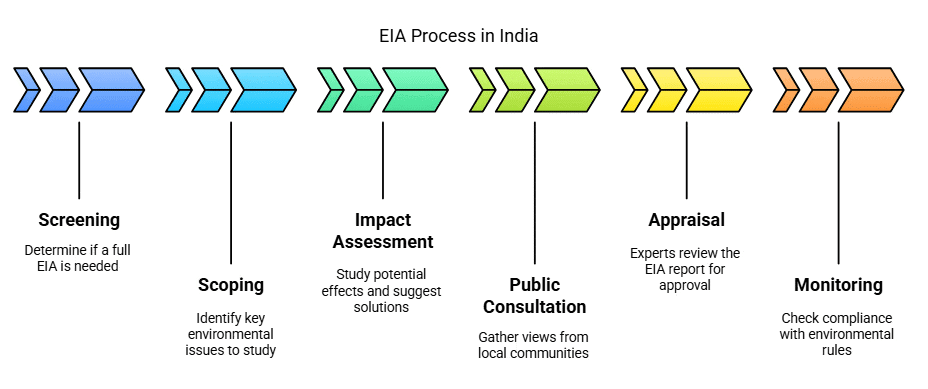
1. Screening
Screening is the first step in the EIA process. It determines whether a project requires a full EIA or can be exempted from it. This step is like a filter to decide how much environmental scrutiny a project needs based on its size, scale, and potential impact.
Purpose
To classify projects into:
- Category A (large projects requiring full EIA and clearance from the MoEFCC).
- Category B1 (smaller projects requiring full EIA and clearance from SEIAA).
- Category B2 (projects exempted from full EIA but needing other clearances).
- To ensure only projects with significant environmental impacts undergo detailed assessment.
Process
1. For Category A Projects:
- Automatically require a full EIA (no screening needed).
- Evaluated by the Expert Appraisal Committee (EAC) under the MoEFCC.
2. For Category B Projects:
- The State Environment Impact Assessment Authority (SEIAA) reviews the project details (e.g., size, location, and type).
- Decides if the project is B1 (full EIA needed) or B2 (EIA exempted).
Stakeholders
- Project Proponent: The developer or company proposing the project submits initial details.
- EAC (for Category A): Central-level experts who assess large projects.
- SEIAA (for Category B): State-level authority responsible for smaller projects.
Key Issue
Arbitrary Categorization: Some projects may be wrongly classified as B2 (exempted) to avoid scrutiny, especially if guidelines are unclear or influenced by external pressures.
Exemptions: Certain projects (e.g., small-scale or strategic projects) may be exempted without proper justification, risking environmental harm.
2. Scoping
Scoping is the second step, where the key environmental issues that need to be studied in the EIA report are identified. It’s like creating a roadmap for the EIA study to ensure all important impacts are covered.
Purpose
- To focus the EIA study on the most significant environmental, social, and economic impacts.
- To prepare a Terms of Reference (ToR), which is a detailed guideline for what the EIA report should include.
Process
- The project proponent submits a preliminary report (e.g., project plan, location, and potential impacts).
- The EAC (for Category A) or SEIAA(for Category B) reviews the report and:
- Identifies key issues (e.g., air pollution, water use, impact on forests, or local communities).
- Prepares the ToR, which outlines what the EIA study must cover (e.g., data collection, impact analysis, mitigation measures).
- The ToR is shared with the project proponent, who then hires an accredited consultant to prepare the EIA report based on the ToR.
Stakeholders
- Project Proponent: Provides initial project details.
- EAC/SEIAA: Sets the ToR and ensures the study focuses on critical issues.
- EIA Consultant: A professional agency hired to conduct the EIA study.
Key Issue
- Inadequate ToR: If the ToR misses important issues (e.g., impact on rare wildlife or groundwater), the EIA report may be incomplete or misleading.
- Lack of Expertise: Poorly designed ToRs can result from limited expertise or rushed processes, leading to weak assessments.
3. Public Consultation
Public Consultation is the third step, where local communities, stakeholders, and the public are given a chance to share their opinions and concerns about the project. It’s a way to make the EIA process transparent and inclusive.
Purpose
- To gather feedback from people who may be affected by the project (e.g., farmers, residents, or indigenous groups).
- To ensure the EIA report considers local knowledge and concerns.
- To promote transparency and accountability in decision-making.
Process
Public Consultation has two main components:
1. Public Hearing:
- A meeting organized by the State Pollution Control Board (SPCB) in coordination with district authorities (e.g., District Magistrate).
- Held near the project site to allow affected communities to attend.
- People can voice their concerns, ask questions, or suggest changes to the project.
- The hearing is recorded, and minutes are included in the EIA report.
2. Written Submissions:
- Stakeholders can submit written feedback or objections within a specified period (usually 30 days).
- These submissions are considered during the appraisal stage.
Exemptions: Some projects (e.g., defense, strategic, or offshore projects) may skip public consultation for security or other reasons.
Stakeholders
- Local Communities: People living near the project site who may face impacts like displacement or pollution.
- SPCB: Conducts the public hearing and ensures it follows guidelines.
- District Authorities: Provide logistical support and maintain order during hearings.
- Project Proponent: Presents the project details and responds to public queries.
- NGOs and Activists: Often participate to raise environmental or social concerns.
Key Issue
- Limited Public Awareness: Many people, especially in rural areas, may not know about the hearing or understand the project’s impacts.
- Language Barriers: Technical terms or lack of translation can make it hard for locals to participate.
- Suppression of Dissent: In some cases, public hearings may be poorly publicized, rushed, or influenced to limit opposition.
- Accessibility: Hearings held far from affected areas or at inconvenient times can exclude vulnerable groups.
4. Appraisal
Appraisal is the fourth step, where the EIA report is thoroughly reviewed to decide whether the project should receive Environmental Clearance (EC) or be rejected. It’s like a final exam for the project.
Purpose
- To evaluate the EIA report for accuracy, completeness, and effectiveness of proposed mitigation measures.
- To consider public feedback and ensure the project aligns with environmental laws.
- To make an informed decision about approving, rejecting, or modifying the project.
Process
- The project proponent submits the final EIA report, including public consultation records.
- The EAC (for Category A) or SEIAA(for Category B) reviews:
- The predicted environmental, social, and economic impacts.
- Mitigation measures proposed to reduce harm (e.g., pollution control or relocation plans).
- Feedback from public consultation.
- The committee may ask for clarifications or additional studies if the report is incomplete.
Outcome:
- Approval: EC is granted with conditions (e.g., regular monitoring or specific safeguards).
- Rejection: The project is denied if impacts are too severe or mitigation is inadequate.
- Revision: The proponent may be asked to revise the report or project plan.
Stakeholders
- EAC/SEIAA: Expert committees responsible for reviewing the EIA report.
- Project Proponent: Submits the EIA report and responds to queries.
- EIA Consultant: May assist in clarifying technical details.
- Public: Their feedback (from public consultation) is considered during appraisal.
Key Issue
- Biased Appraisals: Allegations that committees may favor project proponents due to political or economic pressures.
- Inadequate Scrutiny: Rushed reviews or lack of expertise can lead to approval of flawed projects.
- Ignoring Public Feedback: In some cases, public concerns raised during hearings may not be adequately addressed.
5. Post-Clearance Monitoring
After a project receives Environmental Clearance (EC), Post-Clearance Monitoring ensures that the project follows the conditions outlined in the EC. It’s like keeping an eye on the project to make sure it doesn’t harm the environment.
Purpose
- To verify that the project complies with environmental safeguards and mitigation measures.
- To detect and address any violations or unexpected impacts.
- To ensure long-term sustainability and accountability.
Process
The project proponent must:
- Implement mitigation measures (e.g., installing pollution control equipment or restoring affected areas).
- Submit regular compliance reports (usually every six months) to the authorities.
Monitoring is conducted by:
- Regional offices of the MoEFCC: For Category A projects.
- State Pollution Control Boards (SPCBs): For Category B projects.
If violations are found, authorities can:
- Issue warnings or fines.
- Suspend or revoke the EC.
- Require corrective actions.
Stakeholders
- Project Proponent: Responsible for complying with EC conditions and submitting reports.
- MoEFCC Regional Offices: Monitor Category A projects.
- SPCBs: Monitor Category B projects and ensure compliance.
- Local Communities/NGOs: May report violations or raise concerns about non-compliance.
Key Issue
- Weak Enforcement: Limited resources or lack of regular inspections can lead to undetected violations.
- Non-Compliance: Some project proponents fail to follow EC conditions, causing environmental harm.
- Delayed Action: Authorities may be slow to respond to violations, allowing damage to continue.
- Lack of Transparency: Compliance reports may not be publicly accessible, reducing accountability.
Challenges in the EIA Process
While the EIA process is designed to be thorough, it faces several challenges:
- Misclassification: Projects may be wrongly exempted or categorized to avoid scrutiny.
- Poor Quality EIA Reports: Incomplete or biased reports can undermine the process.
- Limited Public Participation: Awareness, accessibility, and suppression issues can exclude communities.
- Weak Monitoring: Lack of resources or enforcement can lead to unchecked violations.
- External Pressures: Political or economic interests may influence decisions at various stages.
Institutional Framework of the EIA Process in India
The Environmental Impact Assessment (EIA) process in India is managed by a structured institutional framework involving various authorities at the central and state levels. These institutions work together to formulate policies, evaluate projects, involve the public, monitor compliance, and resolve disputes. Below is a detailed explanation of the key authorities, their roles, responsibilities, and the division of powers, presented in simple language for easy understanding.
Key Authorities in the EIA Process
The EIA process involves five main authorities, each with specific functions to ensure environmental protection and sustainable development:
1. Ministry of Environment, Forest and Climate Change (MoEFCC)
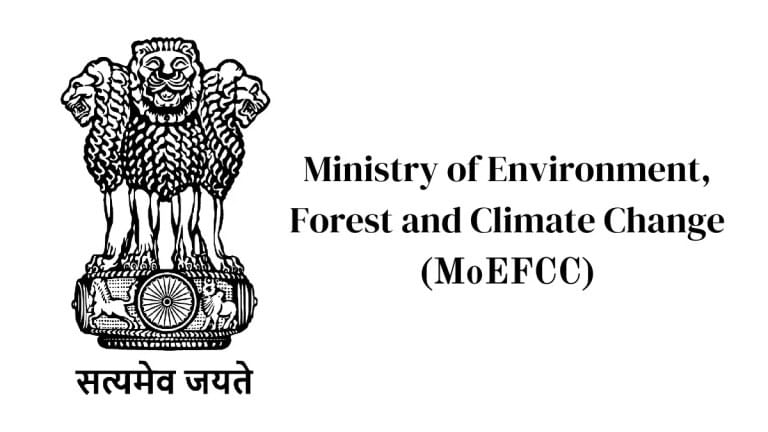 Role
Role
The MoEFCC is the central authority responsible for overseeing the entire EIA process in India. It acts as the policymaker and decision-maker for large-scale projects.
Responsibilities
- Formulates EIA Policies: Issues regulations like the EIA Notification, 2006, and its amendments to guide the EIA process.
- Grants Environmental Clearance (EC): Approves or rejects Category A projects (e.g., large dams, nuclear power plants, airports) based on recommendations from the Expert Appraisal Committee (EAC).
- Sets Guidelines: Develops standards for environmental assessments, public consultations, and compliance monitoring.
- Monitors Compliance: Oversees compliance for Category A projects through its regional offices.
- Coordinates with States: Ensures state-level authorities follow national environmental policies.
Importance
The MoEFCC is the backbone of the EIA process, ensuring that environmental laws are enforced and projects align with India’s sustainability goals.
2. Expert Appraisal Committee (EAC)
Role
The EAC is a technical body at the central level that provides expert advice to the MoEFCC for evaluating Category A projects.
Responsibilities
Screening and Scoping:
- Reviews project proposals to confirm they require a full EIA (Category A projects automatically do).
- Prepares the Terms of Reference (ToR) to guide the EIA study, identifying key environmental issues to be studied.
Appraisal:
- Evaluates the final EIA report, public consultation feedback, and proposed mitigation measures.
- Recommends whether the MoEFCC should grant EC, reject the project, or ask for revisions.
Technical Expertise:
Consists of experts in fields like ecology, pollution control, and engineering to ensure thorough assessments.
Importance
The EAC ensures that Category A projects, which have significant environmental impacts, are rigorously evaluated by qualified professionals.
3. State Environment Impact Assessment Authority (SEIAA)
Role
The SEIAA is a state-level authority responsible for managing the EIA process for Category B projects (smaller projects with less severe impacts).
Responsibilities
- Screening: Determines whether a Category B project is B1 (requires full EIA) or B2 (exempted from EIA).
- Scoping: Prepares the ToR for Category B1 projects to guide the EIA study.
- Appraisal:
- Reviews the EIA report, public feedback, and mitigation measures for Category B1 projects.
- Grants or rejects EC for Category B projects.
- Coordination: Works with the State Pollution Control Boards (SPCBs) and other state authorities to ensure compliance with national guidelines.
Importance
The SEIAA decentralizes the EIA process, allowing state-level authorities to handle smaller projects efficiently while following national standards.
4. State Pollution Control Boards (SPCBs)
 Role
Role
The SPCBs are state-level bodies responsible for conducting public consultations and monitoring compliance for both Category A and B projects.
Responsibilities
Public Hearings:
- Organizes and conducts public hearings during the public consultation stage, in coordination with district authorities (e.g., District Magistrate).
- Ensures local communities can voice their concerns about the project.
- Records feedback and includes it in the EIA report.
Compliance Monitoring:
- Monitors Category B projects to ensure they follow EC conditions (e.g., pollution control measures or restoration plans).
- Conducts inspections and reviews compliance reports submitted by project proponents.
Pollution Control:
Ensures projects comply with air, water, and noise pollution standards set under environmental laws.
Importance
SPCBs play a critical role in involving communities and ensuring projects adhere to environmental regulations at the state level.
5. National Green Tribunal (NGT)
Role
The NGT is a specialized judicial body that resolves EIA-related disputes and ensures compliance with environmental laws.
Responsibilities
Adjudicates Disputes:
- Hears cases related to EIA violations, such as illegal clearances, non-compliance with EC conditions, or failure to conduct proper public consultations.
- Example: If a project starts without EC or causes environmental harm, affected communities or NGOs can approach the NGT.
Ensures Compliance:
Issues orders to enforce EC conditions or penalize violators (e.g., fines, project suspension, or restoration).
Reviews Decisions:
Examines appeals against EC approvals or rejections by the MoEFCC or SEIAA.
Promotes Accountability:
Holds project proponents, authorities, and polluters accountable for environmental damage.
Importance
The NGT acts as a watchdog, providing a legal platform to address environmental grievances and uphold the integrity of the EIA process.
Division of Powers: Central vs. State Authorities
The EIA process in India is designed to balance central oversight with state-level autonomy. Here’s how powers are divided:
Central Authorities (MoEFCC and EAC)
- Scope: Handle Category A projects, which are large-scale and have significant environmental impacts (e.g., nuclear power plants, major highways).
- Role:
- The MoEFCC sets national policies, issues regulations, and grants EC for Category A projects.
- The EAC provides technical expertise for screening, scoping, and appraisal of Category A projects.
- Monitoring: Regional offices of the MoEFCC monitor compliance for Category A projects.
- Examples: Large dams, airports, and industrial estates.
State Authorities (SEIAA and SPCBs)
- Scope: Manage Category B projects, which are smaller and have localized impacts (e.g., small-scale mining, construction projects).
- Role:
- The SEIAA conducts screening, scoping, and appraisal for Category B projects and grants EC.
- The SPCBs organize public hearings and monitor compliance for Category B projects (and assist with Category A public hearings).
- Monitoring: SPCBs oversee compliance for Category B projects.
- Examples: Small industries, housing complexes, and minor irrigation projects.
Coordination
- The MoEFCC provides overarching guidelines to ensure consistency across states.
- The SEIAA and SPCBs follow these guidelines but have autonomy to address state-specific issues.
- The NGT acts as a neutral arbiter, resolving disputes between central/state authorities, project proponents, and affected communities.
This division ensures that large, high-impact projects are scrutinized at the national level, while smaller projects are managed locally for efficiency.
Role of the National Green Tribunal (NGT) in EIA Violations
The NGT, established under the National Green Tribunal Act, 2010, plays a crucial role in addressing EIA violations and ensuring environmental justice. Its key contributions include:
1. Reviewing Illegal Clearances
The NGT investigates cases where EC is granted without following proper procedures, such as:
- Inadequate EIA reports (e.g., missing key impacts or falsified data).
- Skipped or poorly conducted public consultations.
- Arbitrary exemptions for projects that should require an EIA.
- Example: In 2019, the NGT halted a project in Tamil Nadu for starting construction without a valid EC, ordering a fresh EIA.
2. Addressing Non-Compliance
The NGT takes action against projects that violate EC conditions, such as:
- Exceeding pollution limits.
- Failing to implement mitigation measures (e.g., not restoring affected forests).
- Operating beyond the approved scope.
- Example: The NGT imposed fines on industries in Uttar Pradesh for discharging untreated effluents, violating EC conditions.
3. Protecting Community Rights
- The NGT ensures that public consultation is meaningful and that community concerns are addressed.
- It hears petitions from affected communities, NGOs, or activists about projects that threaten livelihoods, health, or cultural sites.
- Example: In 2020, the NGT ordered a review of a highway project in Goa after locals raised concerns about deforestation and inadequate public hearings.
4. Promoting Accountability
The NGT can:
- Impose penalties or fines on violators.
- Suspend or cancel EC for non-compliant projects.
- Order restoration of damaged ecosystems (e.g., replanting trees or cleaning polluted rivers).
- It holds both project proponents and authorities (e.g., MoEFCC or SEIAA) accountable for lapses.
5. Setting Precedents
NGT rulings set legal precedents that strengthen the EIA process, such as:
- Emphasizing the importance of public participation.
- Reinforcing the need for rigorous appraisals and compliance monitoring.
- Example: The NGT’s ruling in the Sterlite Copper case (Tamil Nadu) highlighted the need for strict compliance with pollution norms, influencing future EIA appraisals.
Why the NGT Matters
- Accessibility: Affected communities, even in remote areas, can approach the NGT to seek justice.
- Speedy Resolution: The NGT resolves cases faster than regular courts, ensuring timely action.
- Environmental Focus: Its specialized focus on environmental issues ensures expert handling of EIA disputes.
Challenges in the Institutional Framework
While the institutional framework is robust, it faces some challenges:
- Resource Constraints: MoEFCC regional offices and SPCBs often lack staff or funding for effective monitoring.
- Expertise Gaps: EAC and SEIAA may lack specialists in certain fields, affecting appraisal quality.
- Coordination Issues: Delays or miscommunication between central and state authorities can slow down the process.
- External Pressures: Allegations of political or corporate influence on MoEFCC, EAC, or SEIAA decisions.
- NGT Overburden: The NGT handles a high volume of cases, which can delay resolutions.
Judicial Precedents and Case Laws
Judicial precedents are court decisions that guide future cases with similar issues. In India, courts have played a major role in interpreting and enforcing environmental laws, especially those related to EIA and environmental clearances. Below are key landmark cases that highlight how courts address issues like non-compliance, public participation, and sustainable development.
Key Landmark Cases
1. T.N. Godavarman Thirumulpad v. Union of India (1997)
What’s the case about?
- This case is one of the most important for forest conservation in India. It began when T.N. Godavarman filed a petition to protect forests from illegal deforestation.
- The Supreme Court took a broad view, addressing not just one forest but forest conservation across India.
Key Issue: The court examined how projects (like mining or dams) get environmental clearances and whether they harm forests.
Court’s Decision:
- The court defined what a "forest" is, even if the government didn’t officially classify it as one.
- It banned non-forest activities (like mining or construction) in forests without prior approval from the central government.
- It set up the Central Empowered Committee (CEC) to monitor forest conservation and ensure compliance with environmental clearances.
Significance for EIA:
- Emphasized strict adherence to environmental clearance processes.
- Highlighted the need to protect forests as part of sustainable development.
2. Indian Council for Enviro-Legal Action v. Union of India (1996)
What’s the case about?
- This case dealt with industries in Rajasthan polluting water and land by dumping untreated waste.
- The petitioner argued that industries should bear the cost of cleaning up the damage they caused.
Key Issue: Should polluters pay for environmental damage? This is called the Polluter Pays Principle.
Court’s Decision:
- The Supreme Court ruled that industries causing pollution must pay for cleanup and compensate affected communities.
- It enforced strict liability, meaning industries are responsible even if they didn’t intend to pollute.
Significance for EIA:
- Strengthened the idea that EIA must assess potential pollution risks before projects start.
- Ensured industries follow environmental norms to avoid costly penalties.
3. Lafarge Umiam Mining Pvt. Ltd. v. Union of India (2011)
What’s the case about?
Lafarge, a cement company, was mining limestone in Meghalaya, a tribal area. The project required environmental clearance and affected tribal lands.
Key Issue:
Did Lafarge follow proper EIA procedures? Were tribal rights respected?
Court’s Decision:
- The Supreme Court allowed the project but imposed strict conditions.
- It emphasized that EIAs must include tribal consultations and assess impacts on local communities.
- The court ordered Lafarge to restore mined areas and contribute to local development.
Significance for EIA:
- Highlighted the importance of public participation in EIAs, especially for tribal and indigenous communities.
- Stressed that EIAs must balance development with environmental and social impacts.
4. Vedanta Case (Sterlite Industries, 2013)
What’s the case about?
Vedanta’s Sterlite copper plant in Tamil Nadu was challenged for polluting air and water, violating environmental clearances.
Key Issue:
Did Vedanta comply with environmental clearance conditions? Was public interest ignored?
Court’s Decision:
- The Supreme Court shut down the plant temporarily for non-compliance with environmental norms.
- It later allowed the plant to operate under strict monitoring but imposed a hefty fine for past violations.
Significance for EIA:
- Showed that courts prioritize public health and environment over industrial profits.
- Emphasized that EIAs must be strictly followed, and violations can lead to project closures.
5. Alembic Pharmaceuticals Case (2020)
What’s the case about?
Alembic Pharmaceuticals started a project without proper environmental clearance and later sought retrospective clearance (approval after starting work).
Key Issue: Can projects get environmental clearances after breaking rules?
Court’s Decision:
- The Supreme Court criticized retrospective clearances, saying they undermine the EIA process.
- However, it allowed the project to continue with penalties, considering economic impacts if shut down.
Significance for EIA:
- Highlighted the problem of non-compliance with EIA rules.
- Showed courts’ struggle to balance development with environmental protection.
How Courts Address Key Issues
- Non-Compliance with EIA Procedures: Courts have consistently ruled that projects must follow EIA processes, like getting clearances before starting work. Violations lead to fines, project halts, or strict conditions (e.g., Vedanta, Alembic cases).
- Public Participation: Courts emphasize that EIAs must involve local communities, especially tribal groups (e.g., Lafarge case). Public hearings are critical for transparency and fairness.
- Sustainable Development: Courts aim to balance development with environmental protection. They promote principles like the Polluter Pays Principle and sustainable practices (e.g., T.N. Godavarman case).
International Context of EIA Frameworks
India’s EIA framework is influenced by global conventions and principles. Below is an overview of key international frameworks and how India’s system compares.
Global EIA Frameworks
1. Rio Declaration, 1992
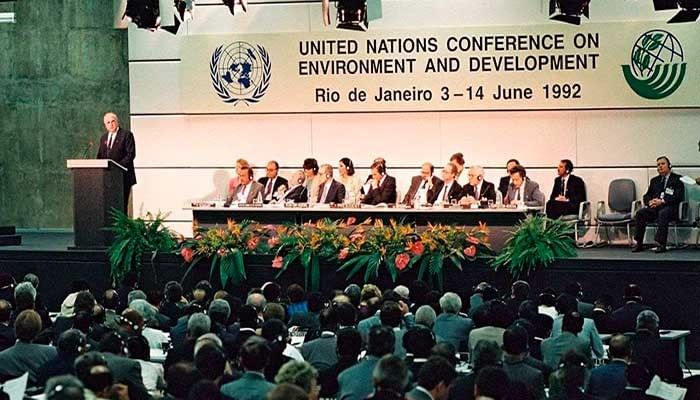 What is it?
What is it?
A set of 27 principles adopted at the United Nations Conference on Environment and Development (Earth Summit) in Rio de Janeiro.
Key Principle for EIA:
Principle 17: Countries must conduct EIAs for projects that may harm the environment.
Influence on India:
India’s EIA Notification (1994, updated in 2006) was inspired by this principle, requiring EIAs for major projects like dams, mines, and industries.
2. Convention on Biological Diversity (CBD)
 What is it?
What is it?
A global treaty to protect biodiversity, signed by India and many other countries.
Key Aspect for EIA:
Requires EIAs to assess impacts on biodiversity (e.g., forests, wetlands, or endangered species).
Influence on India:
India’s EIAs must evaluate how projects affect biodiversity, especially in ecologically sensitive areas like the Western Ghats or Sundarbans.
3. Aarhus Convention
What is it?
A UN treaty focused on public access to environmental information, participation, and justice.
Key Aspect for EIA:
Emphasizes public participation in environmental decision-making, including EIAs.
Influence on India:
India is not a signatory, but its EIA rules include public hearings to involve communities, aligning with Aarhus principles.
Comparison with India
Similarities with Global Standards:
Like global frameworks, India requires EIAs for major projects and emphasizes public consultation (e.g., public hearings mandated by EIA Notification 2006).
India incorporates biodiversity assessments, as required by the CBD.
Differences from Global Standards:
Stricter Timelines: India has fixed timelines for EIA approvals (e.g., 60 days for appraisal), which can rush the process compared to some countries with flexible timelines.
Public Consultation: India’s public hearings sometimes face criticism for being poorly conducted or ignoring community concerns, unlike stricter mechanisms in Aarhus Convention countries.
Enforcement: Global frameworks like the CBD rely on voluntary compliance, while India’s courts actively enforce EIA rules through landmark judgments.
Contemporary Issues and Developments
EIA remains a hot topic in India due to recent changes, controversies, and global environmental challenges. Below are key contemporary issues
1. EIA Draft Notification, 2020
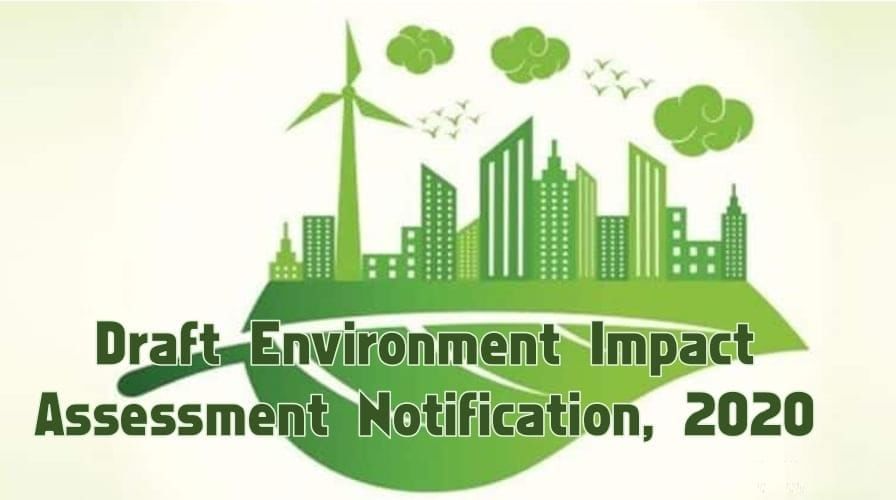 What is it?
What is it?
A proposed update to India’s EIA Notification 2006, released for public feedback in 2020.
Key Changes:
- Exemptions: Certain projects (e.g., small-scale industries) may not need full EIAs.
- Reduced Public Consultation: Public hearing periods shortened from 30 to 20 days, limiting community input.
- Post-Facto Clearances: Allows projects that started without clearance to apply later, legalizing violations.
Criticisms:
- Environmentalists: Say it weakens environmental protection by favoring industries.
- Legal Experts: Argue that post-facto clearances violate the principle of prior assessment.
- Public: Concerned about reduced transparency and participation.
Current Status (as of April 2025):
The draft remains controversial, with ongoing debates about balancing development and environmental protection.
2. Recent Environmental Controversies
Several projects have sparked debates over EIA compliance:
Char Dham Highway:
- A massive road project in the Himalayas to connect pilgrimage sites.
- Issue: Critics argue the EIA ignored risks like landslides and deforestation in a fragile ecosystem.
- Status: Courts have intervened, ordering stricter environmental monitoring.
Vizhinjam Port (Kerala):
- A deep-sea port project accused of bypassing proper EIA processes.
- Issue: Alleged impacts on marine life and coastal communities were not adequately studied.
- Status: Protests and legal challenges continue.
Adani’s Mundra Projects (Gujarat):
- Industrial and port projects criticized for violating environmental clearances.
- Issue: Alleged damage to mangroves and coastal ecosystems.
- Status: Courts have imposed fines and restoration measures.
3. Emerging Issues
- Climate Change: EIAs are increasingly expected to assess a project’s carbon footprint and climate risks.
- Biodiversity Loss: Projects in sensitive areas (e.g., Western Ghats) must study impacts on endangered species.
- Cumulative Impact Assessment: EIAs often focus on single projects but fail to study combined impacts of multiple projects in one area (e.g., multiple dams on a river).
4. Sustainable Development Goals (SDGs)
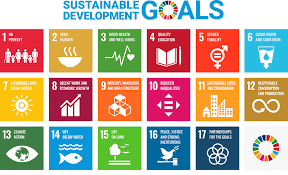 EIAs in India align with global SDGs, especially:
EIAs in India align with global SDGs, especially:
- Goal 13 (Climate Action): EIAs help reduce emissions by assessing project impacts on climate.
- Goal 15 (Life on Land): EIAs protect forests, biodiversity, and ecosystems by ensuring sustainable project planning.
Key Takeaways
- Judicial Precedents: Landmark cases like T.N. Godavarman and Vedanta show that courts prioritize environmental protection, public participation, and sustainable development.
- International Context: India’s EIA framework is inspired by global principles (e.g., Rio Declaration) but differs in timelines and public consultation practices.
- Contemporary Issues: The EIA Draft 2020 and projects like Char Dham highlight ongoing tensions between development and environmental protection.
- SDG Link: EIAs contribute to global goals like climate action and biodiversity conservation.
These notes should help you understand the role of courts, global frameworks, and current challenges in India’s EIA system.
|
39 docs|15 tests
|
FAQs on EIA Framework - Environmental Law - CLAT PG
| 1. What is Environmental Impact Assessment (EIA)? |  |
| 2. What are the objectives of conducting an EIA? |  |
| 3. What is the legal basis for EIA in India? |  |
| 4. Why is EIA considered important in project planning? |  |
| 5. What are the key provisions of the EIA Notification, 2006 in India? |  |
















